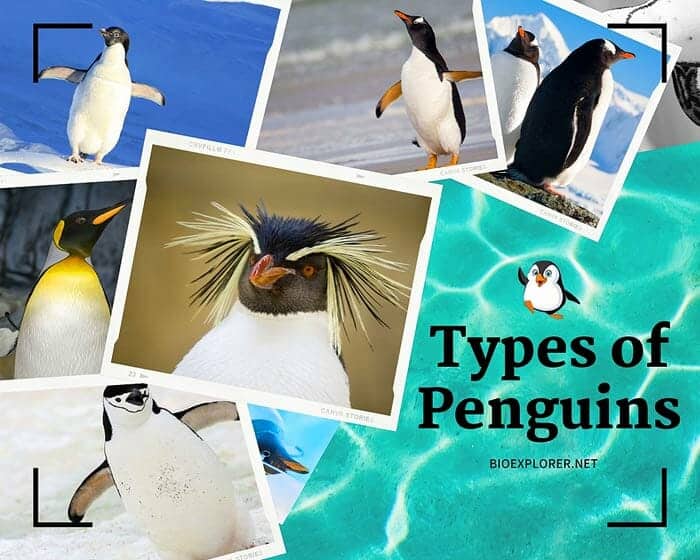
Types of Penguins: Penguins are flightless aquatic birds of the bird order Spheniscidae. These birds are adapted to living in the cold waters and are almost exclusively found in the southern hemisphere. Because of this, penguins have developed thick counter-shaded white and black plumage and turned their forelimbs (wings) into flippers.
Almost all types of Penguins are found exclusively in the Southern Hemisphere except one kind of penguin – Galápagos penguin, which interestingly lives in the hot temperature equator region.
Penguins are remarkably adapted for life in water, and their wings were evolved into flippers for swimming. The krill fish, crustaceans and cephalopods such as squids, and other marine life organisms are the primary food source for penguins.
Interestingly enough, no penguin species are found in the northern hemisphere. Overall, there are about 27 known species of penguins in the world. Let’s explore all types of penguins below:
Types of Penguins
Currently there are 18 main types of penguins and 9 different penguin subspecies have been identified and classified in the bird order – Sphenisciformes.
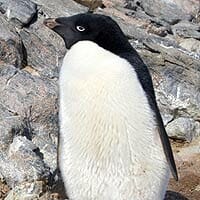
Adélie Penguin (Pygoscelis Adeliae)
Animalia Sphenisciformes Spheniscidae Pygoscelis Pygoscelis adeliae  The Adélie penguin is endemic to the Antarctic continent. They play a vital part in Antarctica’s food chain as both prey and predator. Adelie penguin feeds on krill fish as a predator, and as prey, leopard seals and killer whales eat them. Adélie penguin got its name from Adelie land, which was named for Adele Dumont d’Urville, who marred a French explorer Jules Dumont d’Urville.
The Adélie penguin is endemic to the Antarctic continent. They play a vital part in Antarctica’s food chain as both prey and predator. Adelie penguin feeds on krill fish as a predator, and as prey, leopard seals and killer whales eat them. Adélie penguin got its name from Adelie land, which was named for Adele Dumont d’Urville, who marred a French explorer Jules Dumont d’Urville.A French naval surgeon and naturalist, Jacques Bernard Hombron, and his companion, another French zoologist, Honoré Jacquinot, classified Adelie penguin into bird taxonomy in 1841.
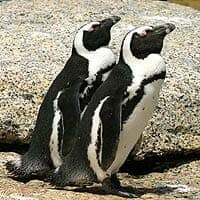
African Penguin (Spheniscus Demersus)
Animalia Sphenisciformes Spheniscidae Spheniscus Spheniscus demersus  The African penguin is another species that mostly lives in Southern Africa countries, including Namibia, Angola, South Africa, and more. Cape penguin, black-footed penguin, jackass penguin, and South African penguin are the other names. African penguins have unique pink skin patches above their eyes which help in thermoregulation. Currently, it is classified as Endangered due to declining population due to habitat loss.
The African penguin is another species that mostly lives in Southern Africa countries, including Namibia, Angola, South Africa, and more. Cape penguin, black-footed penguin, jackass penguin, and South African penguin are the other names. African penguins have unique pink skin patches above their eyes which help in thermoregulation. Currently, it is classified as Endangered due to declining population due to habitat loss.Swedish taxonomist Carl Linnaeus described this bird species in 1758.
Discover African Penguin Fun Facts here.
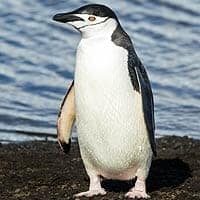
Chinstrap Penguin (Pygoscelis antarcticus)
Animalia Sphenisciformes Spheniscidae Pygoscelis Pygoscelis antarcticus  The Chinstrap penguin is another type of penguin species that inhabits various Southern pacific islands and Antarctic ocean regions, including Argentina, Bouvet Island, Chile, and more. The word ‘Chinstrap’ comes from the appearance of wearing a black helmet. The alternate names of chinstrap penguin are ringed penguin, bearded penguin, and stone cracker penguin. Interestingly chinstrap penguins build a circular nest using stones on land.
The Chinstrap penguin is another type of penguin species that inhabits various Southern pacific islands and Antarctic ocean regions, including Argentina, Bouvet Island, Chile, and more. The word ‘Chinstrap’ comes from the appearance of wearing a black helmet. The alternate names of chinstrap penguin are ringed penguin, bearded penguin, and stone cracker penguin. Interestingly chinstrap penguins build a circular nest using stones on land.In 1781, Johann Reinhold Forster, a Scottish naturalist, added chinstrap penguin into bird taxonomy.
Explore Chinstrap Penguin Fun Facts here.
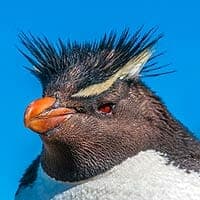
Eastern Rockhopper Penguin (Eudyptes filholi)
Animalia Sphenisciformes Spheniscidae Eudyptes Eudyptes filholi  The Eastern Rockhopper penguin is one of the smallest crested penguins in subantarctic, Southern Indian, and Pacific ocean regions with yellow crest feathers. They are sub-species of the Southern Rockhopper penguin with a unique pink margin around their bills. Per IUCN status, the eastern rockhopper penguin is considered vulnerable due to a declining population due to climate change and scarcity of food sources.
The Eastern Rockhopper penguin is one of the smallest crested penguins in subantarctic, Southern Indian, and Pacific ocean regions with yellow crest feathers. They are sub-species of the Southern Rockhopper penguin with a unique pink margin around their bills. Per IUCN status, the eastern rockhopper penguin is considered vulnerable due to a declining population due to climate change and scarcity of food sources.The taxon author, Captain Frederick Wollaston Hutton, English-New Zealand naturalist, added this penguin species into taxonomy classification in 1879.
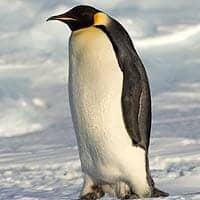
Emperor Penguin (Aptenodytes Forsteri)
Animalia Sphenisciformes Spheniscidae Aptenodytes Aptenodytes forsteri  Considered as the largest among all penguin species, the Emperor penguin is often regarded as the “classic” image that people imagine when they read about or hear the word “penguin”.
Considered as the largest among all penguin species, the Emperor penguin is often regarded as the “classic” image that people imagine when they read about or hear the word “penguin”.An average Emperor penguin can reach up to 4 feet high and weigh up to 88 pounds!
Emperor penguin species is sometimes confused with the King penguin species because of their slight resemblance in terms of physical appearance. However, their distribution around the continent is distinct: Emperor penguins live in the South while King penguins are found in the sub-Antarctic.
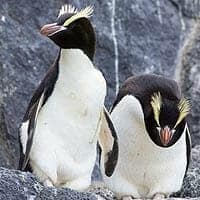
Erect-crested Penguin (Eudyptes Sclateri)
Animalia Sphenisciformes Spheniscidae Eudyptes Eudyptes sclateri  Erect-crested penguins are considered to be one of the largest species of crested penguins. And like other crested penguins, members of this species bear the distinguishing feature of a yellow feather stripe above their eyes that extends from their bills.
Erect-crested penguins are considered to be one of the largest species of crested penguins. And like other crested penguins, members of this species bear the distinguishing feature of a yellow feather stripe above their eyes that extends from their bills.Unlike other species of crested penguins, the Erect-crested penguin can move this yellow crest feathers.
Biologists haven’t fully studied this species of penguins yet. They live in large colonies in the rocky terrain (Bounty and Antipodes Islands) and spends their winters at ocean.
The population of Erect-chest penguins are declining due to its smaller breeding range. The IUCN listed this penguin as endangered on the IUCN red list.
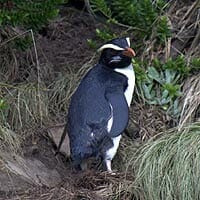
Fiordland Penguin (Eudyptes Pachyrhynchus)
Animalia Sphenisciformes Spheniscidae Eudyptes Eudyptes pachyrhynchus  Fiordland Crested penguins, or simply Fiordland penguins are penguins endemic to the temperate rainforests of New Zealand. These penguins are named after Fiordland, a region in the westernmost of South Island, New Zealand.
Fiordland Crested penguins, or simply Fiordland penguins are penguins endemic to the temperate rainforests of New Zealand. These penguins are named after Fiordland, a region in the westernmost of South Island, New Zealand.Like the Snares penguin, these penguins have a thick stripe of yellow feathers located above their eyes and extends up to the back of their head.
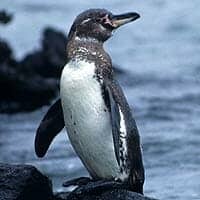
Galápagos Penguin (Spheniscus Mendiculus)
Animalia Sphenisciformes Spheniscidae Spheniscus Spheniscus mendiculus  As its name suggests, the Galápagos penguin is the only penguin species endemic to Galápagos Islands and the north equator. As such, this is the only known penguin species that live further north.
As its name suggests, the Galápagos penguin is the only penguin species endemic to Galápagos Islands and the north equator. As such, this is the only known penguin species that live further north.Penguins of this species have an overall black-greyish plumage and the presence of two black bands that run across their chest.
Galápagos Penguin species is known to be the world’s third smallest penguin.
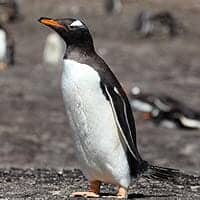
Gentoo Penguin (Pygoscelis Papua)
Animalia Sphenisciformes Spheniscidae Pygoscelis Pygoscelis papua  Gentoo penguins are large sized penguins that are characterized by having distinctive red-orange beaks, slightly orange feet, and white feather caps.
Gentoo penguins are large sized penguins that are characterized by having distinctive red-orange beaks, slightly orange feet, and white feather caps.Regarding size, Gentoo penguins are the third largest penguins. They can reach up to 30 inches high and weigh about 12 lbs.
While these penguins prefer frozen habitats, they can also thrive in ice-free ones like coastal plains and valleys.
-
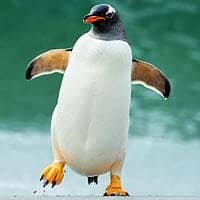
Subantarctic Gentoo Penguin (Pygoscelis papua ssp. papua)
Animalia Sphenisciformes Spheniscidae Pygoscelis Pygoscelis papua papua From the physical dimension perspective, Subantarctic Gentoo Penguin is about 75 cm long and 5 to 6 kgs weight. Like other living penguins, adults have black upperparts and white underparts, and a white triangle above the eyes. The subantarctic Gentoo penguin breeds primarily on the Falkland Islands & South Georgia, Kerguelen Islands, Heard, Macquarie, and Staten Islands. The other common names are Johnny Penguin or Johnny. The current conservation status of the Gentoo Penguin is governed by the Australian legislation act (Environment Protection and Biodiversity Conservation Act 1999).
J. R. Forster (Scotland naturalist) described this species of penguin into the taxonomy classification in 1781.
-
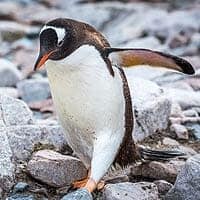
Antarctic Gentoo penguin (Pygoscelis papua ssp. ellsworthi)
Animalia Sphenisciformes Spheniscidae Pygoscelis Pygoscelis papua ellsworthi The Antarctic Gentoo penguin breeds on the Antarctic Peninsula, South Shetland Island, South Orkney, and South Sandwich Island.
American ornithologist and Lamont Curator of birds at the American Museum of Natural History, Robert Cushman Murphy, described this penguin species first in 1947.
-
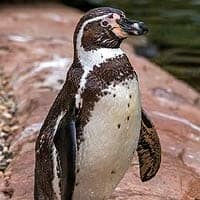
Humboldt Penguin (Spheniscus humboldti)
Animalia Sphenisciformes Spheniscidae Spheniscus Spheniscus humboldti  Humboldt penguins got their name from the cold water current that is coming from the Antarctic and flows to South America (the place itself got its name from the German scientist Friedrich Humboldt).
Humboldt penguins got their name from the cold water current that is coming from the Antarctic and flows to South America (the place itself got its name from the German scientist Friedrich Humboldt).Humboldt penguins have medium sized bodies, large heads, dominantly black plumage, and a distinct black band around their chests.
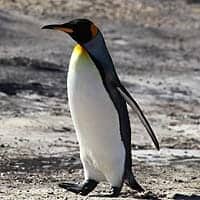
King Penguin (Aptenodytes Patagonicus)
Animalia Sphenisciformes Spheniscidae Aptenodytes Aptenodytes patagonicus  Next, to Emperor penguins, King penguins ranked as the second largest penguins in the world. Aside from that, King penguins are known to be excellent in diving and can reach as deep as 300 meters below.
Next, to Emperor penguins, King penguins ranked as the second largest penguins in the world. Aside from that, King penguins are known to be excellent in diving and can reach as deep as 300 meters below.One notable feature of the King penguin is a gold-orange patch located on both sides of its neck. This patch gradually becomes lighter orange in its upper chest.
King penguin species is one of the few birds that do not use nests for incubating their eggs. Instead, King penguins place their eggs under their bellies on top of their feet.
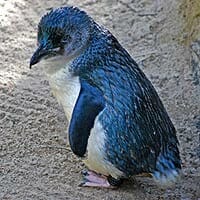
Little Penguin (Eudyptula Minor)
Animalia Sphenisciformes Spheniscidae Eudyptula Eudyptula minor  Little penguins, also called as Fairy penguins are the smallest known species of penguins. They are so small that adults can only weigh up to 2.6 lbs. These penguins have a unique appearance due to their bright bluish-grey feather color (hence the name).
Little penguins, also called as Fairy penguins are the smallest known species of penguins. They are so small that adults can only weigh up to 2.6 lbs. These penguins have a unique appearance due to their bright bluish-grey feather color (hence the name).Interestingly, young Little Blue penguins are white and brown in color that gradually becomes blue as they become adults.
J. R. Forster was the first naturalist who added this species to the taxonomy in 1781.
-
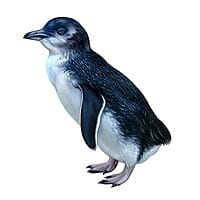
White-Flippered penguin (Eudyptula minor ssp. albosignata)
Animalia Sphenisciformes Spheniscidae Eudyptula Eudyptula minor albosignata The White-Flippered penguin is the smallest penguin species (about 12 inches tall) endemic to New Zealand. This penguin species is a sub-species of little penguins (Eudyptula). White-flippered penguins habitat in caves, headlands, and rock jumbles in Canterbury, New Zealand. In 2010, the white-flippered penguin was listed as endangered under the U.S. Endangered Species Act.
German naturalist Otto Finsch named the taxon for the white-flippered penguin in 1874.
-
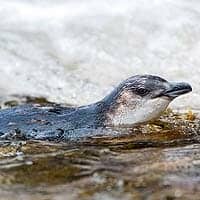
Chatham Island Blue Penguin (Eudyptula minor ssp. chathamensis)
Animalia Sphenisciformes Spheniscidae Eudyptula Eudyptula minor chathamensis Chatham Island Blue Penguin is considered a sub-species of little penguins, found mainly in Chatham Islands shoreline, New Zealand. These rare penguins have blue-shaded skin and white chests. Currently, populations are declining due to human disturbance, mammalian pests, invasive plants around nesting areas, marine food shortages, or biotoxins.
New Zealand museum administrator and ornithologist Robert Falla and F.C. Kinsky added this penguin subspecies in 1976.
-
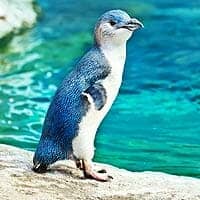
North Island Little Penguin (Eudyptula minor ssp. iredalei)
Animalia Sphenisciformes Spheniscidae Eudyptula Eudyptula minor iredalei In 1911, Australian amateur ornithologist Gregory Mathews coined this subspecies of Little penguin into the taxonomy.
-
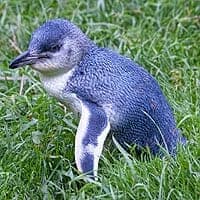
South Island Little Penguin (Eudyptula minor ssp. variabilis)
Animalia Sphenisciformes Spheniscidae Eudyptula Eudyptula minor variabilis New Zealand naturalists, namely Robert Falla and F.C. Kinsky, described this penguin subspecies first in 1976.
-
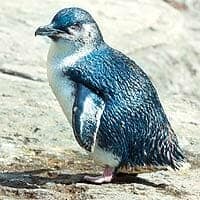
Western & Southern South I. and Stewart I. Little Penguin (Eudyptula minor ssp. minor)
Animalia Sphenisciformes Spheniscidae Eudyptula Eudyptula minor minor Scottish naturalist, J. R. Forster, named this species of penguin into the taxonomy classification in 1781.
-
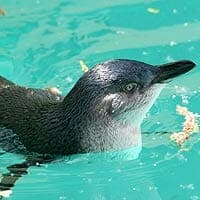
Western Little Penguin (Eudyptula minor ssp. novaehollandiae)
The other name of this little penguin species is Southern Australia & Tasmania Little Penguin. The English naturalist James Francis Stephens classified this penguin subspecies into bird taxonomy in 1826.
-
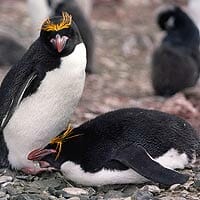
Macaroni Penguin (Eudyptes Chrysolophus)
Animalia Sphenisciformes Spheniscidae Eudyptes Eudyptes chrysolophus  Macaroni penguins are large species of crested penguins that inhabit the sub-Antarctic regions. With a population of about 18 million, these penguins are considered to be the most numerous among all penguin species.
Macaroni penguins are large species of crested penguins that inhabit the sub-Antarctic regions. With a population of about 18 million, these penguins are considered to be the most numerous among all penguin species.Regarding size, these penguins are also considered as one of the largest and heaviest. An average adult Macaroni penguin can reach up to 28 inches high and weigh about 12 lbs.
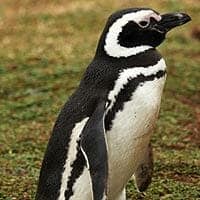
Magellanic Penguin (Spheniscus Magellanicus)
Animalia Sphenisciformes Spheniscidae Spheniscus Spheniscus magellanicus  The Magellanic penguin is a species of penguin that is native to the Falkland Islands and South America. These penguins got their name from Ferdinand Magellan, the explorer who first discovered it in 1519.
The Magellanic penguin is a species of penguin that is native to the Falkland Islands and South America. These penguins got their name from Ferdinand Magellan, the explorer who first discovered it in 1519.Magellanic penguins have distinct white bands over their eyes and black bands on their breasts and bellies.
Normally, these penguins breed in underground burrows. However, when digging is not possible, they simply breed under the bushes.
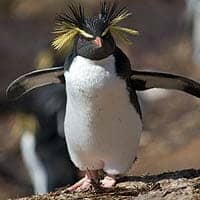
Northern Rockhopper Penguin (Eudyptes Moseleyi)
Animalia Sphenisciformes Spheniscidae Eudyptes Eudyptes moseleyi  Rockhopper penguins were previously classified as a single species. However, due to more extensive analyses, this single taxon has been split into two species: the Northern Rockhopper penguin (Eudyptes moseleyi) and the Southern Rockhopper penguin (Eudyptes chrysocome).
Rockhopper penguins were previously classified as a single species. However, due to more extensive analyses, this single taxon has been split into two species: the Northern Rockhopper penguin (Eudyptes moseleyi) and the Southern Rockhopper penguin (Eudyptes chrysocome).The former is characterized by having a slightly longer and more prominent yellow stripe of feathers above its eyes. In addition to that, its body is smaller and appears to have a greyish plumage color.
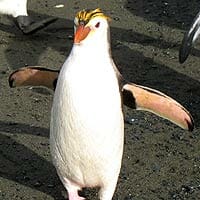
Royal Penguin (Eudyptes Schlegeli)
Animalia Sphenisciformes Spheniscidae Eudyptes Eudyptes schlegeli  The next type of penguin is the Royal penguin that is often characterized as the most beautiful penguin species. The Royal penguin has an orange-pink short and thick beak that has a callus on both sides of the base.
The next type of penguin is the Royal penguin that is often characterized as the most beautiful penguin species. The Royal penguin has an orange-pink short and thick beak that has a callus on both sides of the base.The Royal penguin is widely distributed among the islands of Bishop, Clerk, and Macquarie Islands in Australia, Falkland Islands, South Sandwich Islands, and the Falkland Islands.
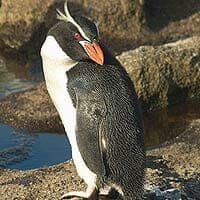
Snares Penguin (Eudyptes Robustus)
Animalia Sphenisciformes Spheniscidae Eudyptes Eudyptes robustus  Native to the Snares Islands, the Snare penguin is pretty much very similar to the Fiordland penguin.
Native to the Snares Islands, the Snare penguin is pretty much very similar to the Fiordland penguin.Regarding physical appearance, this penguin species is characterized by having an upward yellow facial stripe of a feather that extends up to its bill, crest feather plumes, and a cone-shaped bill.
This type of penguin is considered to be the most restricted penguin in term of its distribution because the range of its breeding is only restricted to the Snares group.
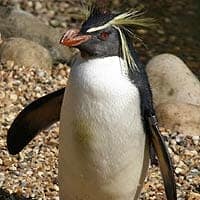
Southern Rockhopper Penguin (Eudyptes Chrysocome)
Animalia Sphenisciformes Spheniscidae Eudyptes Eudyptes chrysocome  Found in the islands of Chile, New Zealand, and some parts of North Antarctica, Southern Rockhopper penguins appear to be peculiar because they tend to bound instead waddling like what other species of penguins do.
Found in the islands of Chile, New Zealand, and some parts of North Antarctica, Southern Rockhopper penguins appear to be peculiar because they tend to bound instead waddling like what other species of penguins do.Southern Rockhopper penguins are characterized by their distinguishable spiky stripe of yellow and black feathers on the top of their heads.
The Eastern Rockhopper penguin (Eudyptes filholi), another type of Rockhopper penguin, is often considered by scientists to be a mere subspecies of the Southern Rockhopper and not a sole species per se.
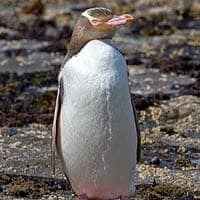
Yellow-eyed Penguin (Megadyptes Antipodes)
Animalia Sphenisciformes Spheniscidae Megadyptes Megadyptes antipodes  Last penguin species in our types of penguins list is the Yellow-eyed penguin that is believed to be the rarest of all penguin species. This penguin species is distributed in the northern parts of the Antarctic oceans, particularly in the islands of Auckland, Campbell, and Stewart in New Zealand.
Last penguin species in our types of penguins list is the Yellow-eyed penguin that is believed to be the rarest of all penguin species. This penguin species is distributed in the northern parts of the Antarctic oceans, particularly in the islands of Auckland, Campbell, and Stewart in New Zealand.As its name suggests, the Yellow-eyed penguin is characterized by its very prominent yellow-colored eyes and yellow bands around its eyes and head.
![]()
Penguin Species By Taxonomists
Here is the list of penguins and their corresponding taxonomists who have first identified and classified them into the bird taxonomy.
| Adélie Penguin | Pygoscelis adeliae | Jacques Bernard Hombron & Honoréé Jacquinot | French Naturalist / French Zoologist | 1841 |
| African Penguin | Spheniscus demersus | Carl Linnaeus | Swedish Taxonomist | 1758 |
| Chinstrap Penguin | Pygoscelis antarcticus | Johann Reinhold Forster | Scottish Naturalist | 1781 |
| Eastern Rockhopper Penguin | Eudyptes filholi | Frederick Wollaston Hutton | English-New Zealand Scientist | 1879 |
| Emperor Penguin | Aptenodytes forsteri | George Robert Gray | English Zoologist | 1844 |
| Erect-Crested Penguin | Eudyptes sclateri | Walter Buller | New Zealand Naturalist | 1888 |
| Fiordland Penguin | Eudyptes pachyrhynchus | George Robert Gray | English Zoologist | 1845 |
| Galapagos Penguin | Spheniscus mendiculus | Carl Jakob Sundevall | Swedish Zoologist | 1871 |
| Gentoo Penguin | Pygoscelis papua | Johann Reinhold Forster | Scottish Naturalist | 1781 |
| ↪ Antarctic Gentoo penguin | Pygoscelis papua ssp. ellsworthi | Robert Cushman Murphy | American Ornithologist | 1947 |
| ↪ Subantarctic Gentoo Penguin | Pygoscelis papua ssp. papua | Johann Reinhold Forster | Scottish Naturalist | 1781 |
| Humboldt Penguin | Spheniscus humboldti | Franz Meyen | Prussia (German State) Scientist | 1834 |
| King Penguin | Aptenodytes patagonicus | John Frederick Miller | English illustrator | 1778 |
| Little Blue Penguin | Eudyptula minor | Johann Reinhold Forster | Scottish Naturalist | 1781 |
| ↪ White-Flippered penguin | Eudyptula minor ssp. albosignata | Otto Finsch | German Naturalist | 1874 |
| ↪ Chatham Island Blue Penguin | Eudyptula minor ssp. chathamensis | Robert Falla and F.C. Kinsky | New Zealand Ornithologists | 1976 |
| ↪ North Island Little Penguin | Eudyptula minor ssp. iredalei | Gregory Mathews | Australian Ornithologist | 1911 |
| ↪ Western & Southern South I. and Stewart I. Little Penguin | Eudyptula minor ssp. minor | Johann Reinhold Forster | Scottish Naturalist | 1781 |
| ↪ Western Little Penguin | Eudyptula minor ssp. novaehollandiae | James Francis Stephens | English Naturalist | 1826 |
| ↪ South Island Little Penguin | Eudyptula minor ssp. variabilis | Robert Falla and F.C. Kinsky | New Zealand Ornithologists | 1976 |
| Macaroni Penguin | Eudyptes chrysolophus | Johann Friedrich von Brandt | German-Russian Naturalist | 1837 |
| Magellanic Penguin | Spheniscus magellanicus | Johann Reinhold Forster | Scottish Naturalist | 1781 |
| Northern Rockhopper Penguin | Eudyptes moseleyi | Gregory Mathews & Tom Iredale | Australian Ornithologist/English Ornithologist | 1921 |
| Royal Penguin | Eudyptes schlegeli | Otto Finsch | German Naturalist | 1876 |
| Snares Penguin | Eudyptes robustus | Walter Oliver | New Zealand Naturalist | 1953 |
| Southern Rockhopper Penguin | Eudyptes chrysocome | Johann Reinhold Forster | Scottish Naturalist | 1781 |
| Yellow-eyed Penguin | Megadyptes antipodes | Jacques Bernard Hombron & Honoréé Jacquinot | French Naturalist / French Zoologist | 1841 |
![]()
Penguin Types By IUCN Status
International Union for Conservation of Nature (IUCN) is the global authority on status of wildlife. The below table describes all penguin types and their corresponding IUCN statuses.
| Adélie Penguin | Pygoscelis adeliae | Least Concern |
| African penguin | Spheniscus demersus | Endangered |
| Chinstrap penguin | Pygoscelis antarcticus | Least Concern |
| Eastern Rockhopper penguin | Eudyptes filholi | Vulnerable |
| Emperor Penguin | Aptenodytes forsteri | Least Concern |
| Erect-crested Penguin | Eudyptes sclateri | Endangered |
| Fiordland Penguin | Eudyptes pachyrhynchus | Nearly Threatened |
| Galapagos Penguin | Spheniscus mendiculus | Endangered |
| Gentoo Penguin | Pygoscelis papua | Least Concern |
| Humboldt Penguin | Spheniscus humboldti | Vulnerable |
| King Penguin | Aptenodytes patagonicus | Least Concern |
| Little Penguin | Eudyptula minor | Least Concern |
| Macaroni Penguin | Eudyptes chrysolophus | Vulnerable |
| Magellanic Penguin | Spheniscus magellanicus | Least Concern |
| Northern Rockhopper Penguin | Eudyptes moseleyi | Endangered |
| Royal Penguin | Eudyptes schlegeli | Nearly Threatened |
| Snares Penguin | Eudyptes robustus | Vulnerable |
| Southern Rockhopper Penguin | Eudyptes chrysocome | Vulnerable |
| Yellow-eyed Penguin | Megadyptes antipodes | Endangered |
![]()
Different Types of Penguins & Their Pictures
 Adelie Penguin
Adelie Penguin African Penguin
African Penguin Chinstrap Penguin
Chinstrap Penguin Eastern Rockhopper penguin
Eastern Rockhopper penguin Emperor Penguin
Emperor Penguin Erect-crested Penguin
Erect-crested Penguin Fiordland Penguin
Fiordland Penguin Galapagos Penguin
Galapagos Penguin Gentoo Penguin
Gentoo Penguin Antarctic Gentoo Penguin
Antarctic Gentoo Penguin Subantarctic Gentoo Penguin
Subantarctic Gentoo Penguin Humboldt Penguin
Humboldt Penguin King Penguin
King Penguin Little Penguin
Little Penguin White-flippered Penguin
White-flippered Penguin Chatham Island Blue Penguin
Chatham Island Blue Penguin North Island Little Penguin
North Island Little Penguin Stewart I. Little Penguin
Stewart I. Little Penguin Western Little Penguin
Western Little Penguin South Island Little Penguin
South Island Little Penguin Macaroni Penguin
Macaroni Penguin Magellanic Penguin
Magellanic Penguin Northern Rockhopper Penguin
Northern Rockhopper Penguin Royal Penguin
Royal Penguin Snares Penguin
Snares Penguin Southern Rockhopper Penguin
Southern Rockhopper Penguin Yellow-eyed Penguin
Yellow-eyed PenguinFrequently Asked Questions
How many species of Penguins exist in Antarctica?
There are 18 species of penguin in Antarctica. They include the abundant species such as the adelie penguin and several others that are listed on the IUCN Red List of Threatened Species.
Can you list some species of penguin found in South Georgia?
South Georgia is home to several penguin species. It hosts an abundant number of breeding pairs of King Penguins, which is the second largest penguin species on the planet. Other species include the macaroni penguin and gentoo penguin.
How different is the Australian Little Penguin from other species?
The Australian little penguin is the smallest species of penguin in the world. It is also known as the Fairy penguin. Unlike many other species, its feathers are blue and white rather than black and white.
What makes the Adelie penguin unique amongst different penguin species in Antarctica?
The Adelie penguin is one of the most southern-dwelling penguins. It is known for its distinctive white ring surrounding the eye. Like many other species, Adelie penguins lay two eggs each breeding season.
Is it true that all species of penguins live in far southern regions?
While many associate penguins with Antarctica, that’s not the case for all species. Some types, like the Galapagos penguin, live near the equator. However, all penguin species are native to the Southern Hemisphere.
What is the largest species of penguin?
The Emperor Penguin is the largest species of penguin. Male and female emperors are similar in size and can reach up to 130 cm (about 51 inches) in height. It’s also one of the species that calls Antarctica home.
Are there any extinct species of penguins?
Yes, there are several extinct species of penguins. One extinct species known is the Waitaha penguin from New Zealand, which became extinct shortly after humans arrived on the islands, about 500 years ago.
What do penguins in Antarctica eat?
Penguins in Antarctica mainly eat krill, a small shrimp-like animal. They also eat fish and squid when available. The exact diet can vary depending on the species of penguin and their location.
How many species of penguins are there in the world?
In total, there are 27 recognized species of penguins in the world. While many inhabit Antarctica, others are found in various parts of the Southern Hemisphere, including Australia, South Africa, and South America.
Why do penguins look different from one species to another?
The different physical aspects of penguins, such as their size, color, and beak shape, are the result of evolution, adapting to their specific environment and diet. For example, Emperor Penguins have a sturdy body to withstand the extreme cold in Antarctica, while african penguins‘ are built more slender to cope with a warmer climate.
















